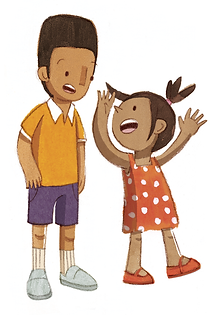

Not sure how to take the next step?
Explore resources to help guide conversations in your home, school, library, or community!

SKIN COLOR
Even babies notice skin color! And every person has a unique skin tone. Simply talking about it helps children learn that it’s not a taboo topic, and can open the door to more in-depth conversations about race.You can talk about skin tone in the same way you notice all the parts of your body. Introduce different skin colors during playtime when you may already be talking about physical attributes like size, shape, and color.
RACE-RELATED OBSERVATIONS
Young children are curious about race and may make race-related observations in close proximity to the person they are wondering about.Though this can be awkward for adults, it’s important not to shut children down.Try making a calm observation, like “I see you’re noticing that ___.” Follow with an affirmation, like “I love how curious you are!” Then redirect if you can’t talk more in the moment: “Right now we need to ___, but I want to talk more about this when we get ___.”


FAMILY DIVERSITY
Young children often think that the way their family looks is the way all families look. Find regular opportunities to point out family diversity and different skin tones within families. Give examples using books, photos, or dolls during playtime.
IDENTITY TERMS
When we aren’t used to talking about race, it can be hard to know where to start or what language to use, and words like Black and white may even seem like “bad words.” They’re not! Having accurate and appropriate language for social identity groups empowers children. Introduce identity terms during play or while reading books to help young children learn the language they need to describe themselves and to be comfortable with human differences.


STEREOTYPES AND PREJUDICE
Children as young as six months categorize people by skin color, and by three years, they may start to demonstrate racial bias. One reason for this is that young children tend to generalize.Try to guide conversations to individuals rather than groups. For example, if a child says, “Daddies go to work,” you can say, “Which daddy are you thinking about?” These shifts in thinking help children learn that generalizations and stereotypes are problematic.
RACE
You may have learned that “race is a social construct,” but what does that really mean? And how do you explain it? Race is an idea that emerged in modern times, and that has no basis in biology or science. Racial categories were invented to advantage white people and to justify slavery, colonialism, and genocide. There are still many people who don’t know or understand this history.To talk about race and racism with young children, it’s important to start or continue the work of understanding it yourself so you are comfortable breaking it down.


RACISM
You have permission to talk to young children not just about diversity and differences, but also about injustice. Young children are already seeing, being impacted by, and perpetuating racism. As the grown-ups in their lives, we should not avoid topics that are confusing, scary, or sad. We need to help them understand and navigate those topics and feelings. Learn how to explain racism in your own words. This will help you find the right words to explain it to young children, and follow their lead when they have questions. Call out racism as it manifests in your own lives and continue to discuss this openly with your children. This will help them do the same as they grow.
EMPOWERMENT AND ACTIVISM
Young children learn more by watching what you do than from what you say about your beliefs. Racism is baked into the culture of the United States. In order to undo this system, we must actively participate in anti-racist efforts.There are so many different ways to get involved! Brainstorm ideas together, and start small in your community.


